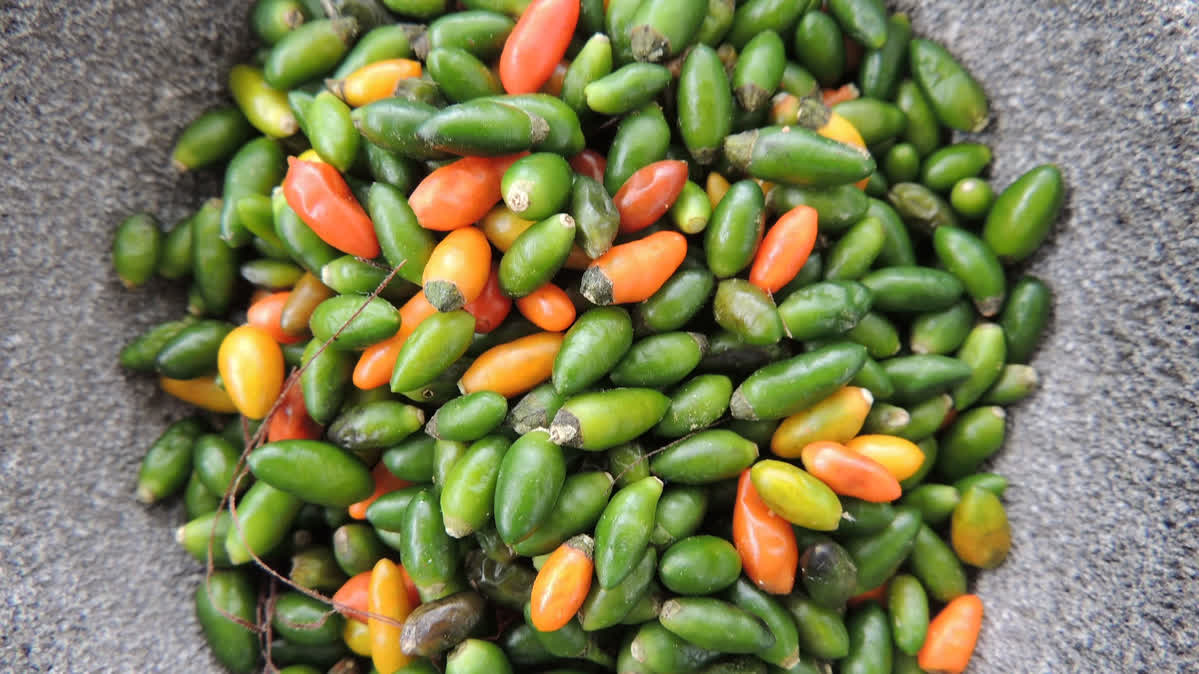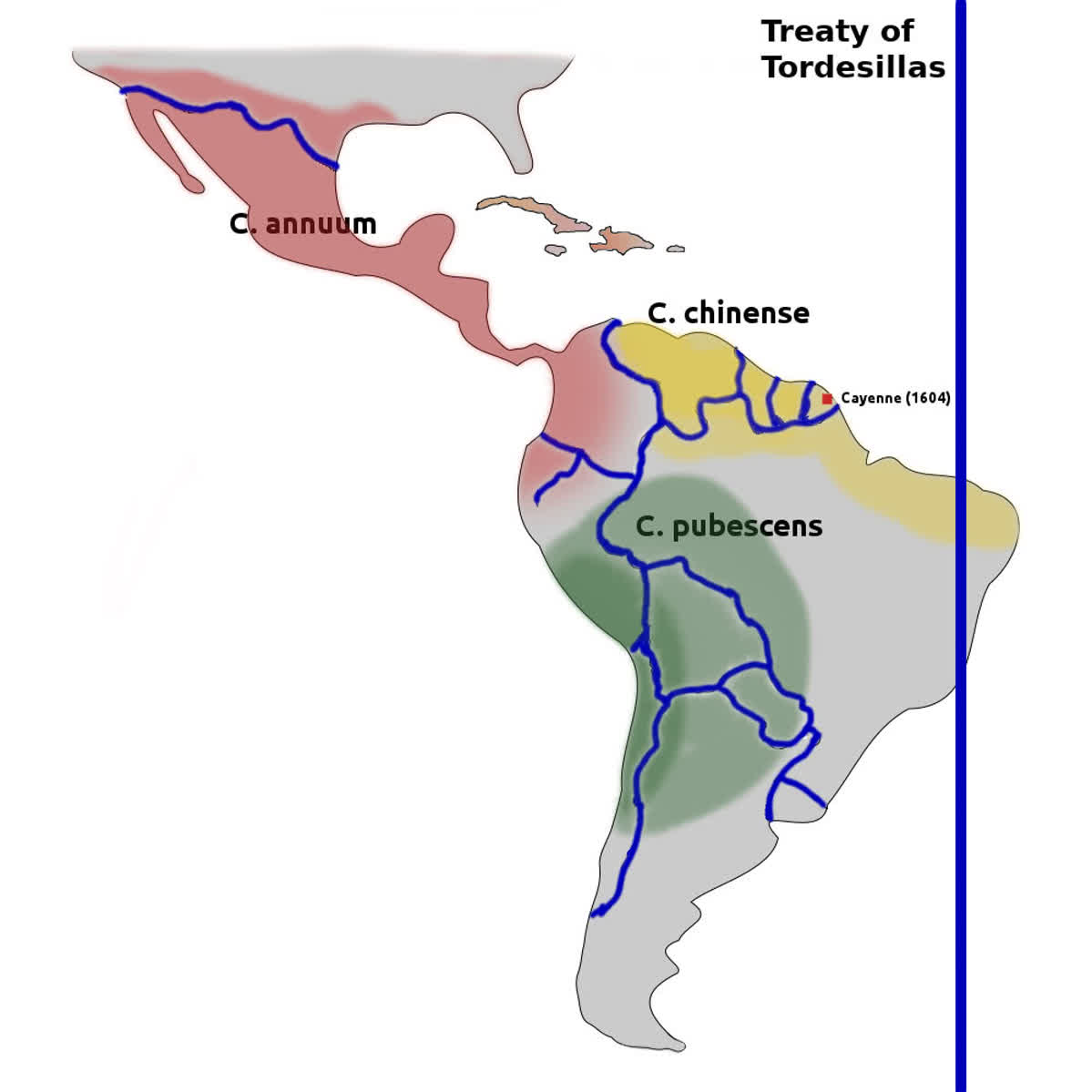Chili history, origin & distribution
In history, until 1492, chillies only existed on the American continent. They were widespread from the south of today’s USA to Argentina. Smaller berries of the Capsicum wild species were already picked by indigenous people in the Tehuacán plain (Mexico) before 8,000 BC 1.
When the first people settled there, they also started to grow chillies. It took about two thousand years until the picking nomads became the first permanent chili farmers.

Chili cultivation around 8,000 years ago🌶
Man does not live by chilies alone. So also pumpkin, avocado and kiwicha - similar to millet - were bred and harvested. In the history between 8,000 and 5,000 B.C. there were already the first chili lovers who bred wild chili plants specifically for yield.
There are still about 28 main wild forms known today. The first domesticated chillies emerged from one of these wild species. Archaeological finds in Oaxaca, also in Mexico, suggest that the first cultivated species was a Capsicum annuum. Chillies are one of the earliest domesticated crops in America.
Wild forms of chillies🌶
One possible wild form from which the large family Capsicum annuum could originate is chiltepin (Capsicum annuum var. glabriusculum). It was probably also the eponym of the hot pepper. The word chili could derive from Chilpoctli, Chiltecpin or Chiltepin from the Aztec language.
Capsicum pubescens had established itself in today’s Bolivia. In the high altitudes of the Andes it coped better with the cooler temperatures. Closely related to the hairy tree chilies is the wild Capsicum eximium. Like the pubescens, it has typical purple flowers. The Capsicum wild type, however, forms smaller, round chili berries.
It is not clear whether Eximium is the original form of pubescens. However, these two species can pollinate each other. This is why hybrids are often formed, which are difficult to determine with certainty. For cross-pollination pubescens is too far away from the Capsicum species: annuum, chinense, frutescens and baccatum because of the number of genes.
The main distribution areas of chili in the history of America before 1492 are shown on this map:

Columbus finds a taste for chili🌶
In October 1492 Christophorus Columbus discovered the New World. At the beginning of November he sent two Spaniards to search the Antilles for black pepper and cinnamon. He gave them samples of spices, as the natives could only communicate with sign language.
Both scouts reported to Columbus two days later that they had met Indians transporting large quantities of cinnamon reeds. Furthermore they had seen red berries the size of nuts among the Indians. Immediately the sailors set off to the places where the cinnamon reed was to grow. The disappointment was certainly very big when it turned out that it was not cinnamon reed. At that time cinnamon and pepper were expensive spices with the value of gold.
Shortly before his return from the West Indian island of Hispanola to Spain, Columbus noted the native word “axi” for chilies in his logbook. He found the “axi” (aji) to be more tasty and healthier than black pepper (Piper nigrum).
None of the natives would eat anything without spicing it with chili. Conquistadors confirmed the statement 20 years later that Mayans and Aztecs ate almost everything with chilies. Even Incas knew about the invigorating effect of chilies and liked to consume them with cocoa, vanilla and tomatoes (love apple) as an aphrodisiac. Christopher Columbus estimated that 50 shiploads of chillies could be shipped annually from La Isla Española (the Spanish island) alone to Spain.
Treaty of Tordesillas🌶
After the return of Columbus, the Pope worried about the peace between Spain and Portugal. For some time there had been disputes about the trade routes along the coast of Africa.
On the basis of previous treaties, Portugal now also registered claims to the land discovered by Columbus. It was only after Columbus’ death that it was recognized that this was a new continent.
Columbus assumed until his death († 20. May 1506) that he had found a western sea route to India. Under these false assumptions, the pope divided the world into two halves by treaty. One Portuguese and one Spanish.
The border was set in the Atlantic Ocean at the level of Greenland in the north and eastern Brazil in the south. England and France were left empty-handed by the papal bull and the Treaty of Tordesillas in 1493.
Distribution of chili after 1493🌶
During the next 150 years, Central America and the western side of South America was settled by Spaniards. Portuguese spread along the east coast around Rio de Janeiro and in the Amazon basin. Especially in the Amazon Basin the pungent Capsicum chinense was originally widespread. Portuguese seafarers ensured its rapid worldwide spread.
Along the coast of Africa Portuguese had established ports and garrisons. In these ports and garrisons the cultivation of chillies was soon started after the first seeds had arrived. Chillies quickly found their way into the kitchens of the local black population. After eating fiery hot chillies, a hot climate is easier to bear.
Spain and Portugal were greedy for gold, spices and tobacco from America. European conquerors brought much suffering and disease to Central and South America in search of wealth. But there was a lack of volunteer workers. As slaves, the proud Indians, tormented by disease, proved to be unsuitable. Obviously, they were not suited to work in underground mines.
Already in 1510 Africans were captured and taken to South America as slaves. About 100 years later in the 16th century the first black African slaves came to North America (Virginia) and brought chillies with them. These were cultivated in the earth around the slave huts. North American Indians were not known to grow chilies and to practice agriculture. However, wild chillies were collected by North American Indians in the area of today’s Arizona and Texas.
When Vasco da Gama circumnavigated the Cape of Good Hope in 1497 and reached India in 1498, the monopoly of Arab, Venetian and Indian spice traders was broken. As a result, the prices of the precious merchandise were reduced. The population’s demand for spices increased. Now these could not only be used by the rich for seasoning dishes and as remedies.
At the end of the Italian war 1521 - 1526, chillies also found their destiny in Italy to be cultivated to make peppers. Some battles were fought on Italian soil with the participation of Venice, Genoa and the Ottoman Empire. Probably in 1526 Italian soldiers plundered the peppers from the Turks.
Portuguese sailors landed at the mouth of the Pearl River in China in 1516. Soon they established a trading post here first with the approval of the Chinese. Over the next 40 years it developed into a respectable port city. It is likely that the port city of Macao had a great influence on the spread of chili in Asia. From here the trade with Japan continued when China banned it in 1547.
Chili quickly became popular in China. The chili variety, which originated in the Amazon Basin, found its way to China via Africa in history. A few hundred years later, when the Capsicum chinense was recognised as an independent variety, it was assumed to have originated in China. This is why the chilli variety got its name Capsicum chinense.
Via the Silk Road the chili first came to Hunan and Sichuan which are still known for their spicy cuisine. Via the trade routes, the chili continued to Thailand, North India, Pakistan, Turkey and Hungary. From Hungary the chili finally arrived relatively late in Eastern Europe and Germany.
It also took a long time to reach England, where the chillies found friends as madras curry. English soldiers who served in India and learned to appreciate Indian cuisine were able to convince the rest of the island of the advantages of the spicy cuisine. Until today only France seems to be reserved towards the fiery hot pods.
500 years ago the nightshade plant with the hot pods was first brought to Europe by the Spanish and Portuguese. It was from here that the fruit started its career as the most popular spice. Today, it is grown everywhere in the tropics up to the temperate zones.
